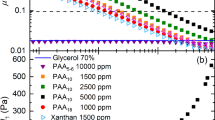Abstract
A RECENT communication1 has described the effect of temperature on the lubricating properties of mineral oils. The apparatus used for the experiments was that devised by Bowden and Leben for analysing the frictional force between sliding surfaces. In this apparatus the bottom surface is driven steadily forward, but the upper surface is mounted on a bifilar suspension so that it has a certain degree of freedom and can respond to any changes in the frictional force. Using this apparatus they have shown that the sliding between steel surfaces lubricated under boundary conditions with certain mineral oils and with other lubricants may not be continuous but may proceed by a process of ‘stick and slip’. In general, this jerky motion is observed with non-polar lubricants which are not adsorbed or are only weakly adsorbed on the metal surfaces. With certain polar molecules, such as the long-chain fatty acids which form strongly adsorbed layers, the motion changes over to continuous sliding. It was also found2 that the polar oxidation products which may be present in solution in some mineral oils or which are formed in the oil by heating may act in a similar way and may cause continuous sliding. The experiments described in the previous communication1 have shown that, if the surfaces are warmed, these adsorbed polar substances may be driven off the surface, and the motion may change over to stick-slip. This transition, which is a reversible one, may occur at quite moderate temperatures, for example, 50° C, and is accompanied by an increase in wear.
This is a preview of subscription content, access via your institution
Access options
Subscribe to this journal
Receive 51 print issues and online access
$199.00 per year
only $3.90 per issue
Buy this article
- Purchase on Springer Link
- Instant access to full article PDF
Prices may be subject to local taxes which are calculated during checkout
Similar content being viewed by others
References
Tabor, NATURE, 145, 308 (1940).
Bowden, Leben and Tabor, Trans. Faraday Soc., 35, 900–904 (1939).
Bowden and Leben, Phil. Trans., A, 239, 1–27 (1940).
Author information
Authors and Affiliations
Rights and permissions
About this article
Cite this article
TABOR, D. Desorption or ‘Surface Melting’ of Lubricant Films. Nature 147, 609–610 (1941). https://doi.org/10.1038/147609a0
Issue Date:
DOI: https://doi.org/10.1038/147609a0
Comments
By submitting a comment you agree to abide by our Terms and Community Guidelines. If you find something abusive or that does not comply with our terms or guidelines please flag it as inappropriate.



